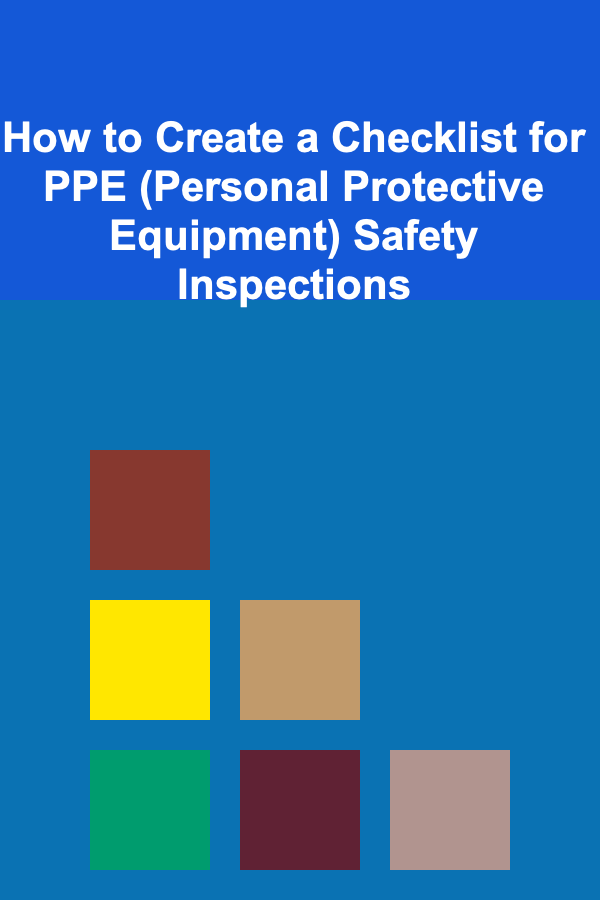
10 Tips for Printing High-Quality Masks at Home
ebook include PDF & Audio bundle (Micro Guide)
$12.99$11.99
Limited Time Offer! Order within the next:

As the world continues to prioritize health and hygiene, the need for personal protective equipment (PPE), such as masks, has risen significantly. Whether you're concerned about air pollution, health safety, or just want to reduce your environmental footprint, printing high-quality masks at home has become a feasible and effective solution. The convenience of DIY mask printing not only helps you create custom masks to suit your preferences but also ensures that you can maintain a steady supply of fresh, high-quality masks whenever you need them.
In this guide, we will discuss ten essential tips for printing high-quality masks at home. These tips will help you ensure that the masks you produce are comfortable, effective, and durable, while also allowing you to customize them to suit your personal style and needs.
1. Choose the Right Materials for Mask Printing
One of the most important factors in printing high-quality masks at home is selecting the right materials. Masks must meet certain criteria, such as breathability, filtration efficiency, and comfort. Here are some materials to consider:
- Cotton Fabric: Cotton is soft, breathable, and can be layered for extra protection. It's an excellent choice for DIY mask printing. You can use cotton fabric with a tight weave to ensure better filtration.
- Polyester or Nylon: These synthetic fabrics are more durable and offer excellent water resistance. They are suitable for creating masks that need to be durable and washable.
- Non-Woven Fabrics: Non-woven fabrics, such as polypropylene, are commonly used in high-performance masks. They offer better filtration than woven fabrics and can be used as an additional layer in your mask.
- Activated Carbon Filters: For added protection against particles and pollutants, you can integrate activated carbon filters into your mask design. These filters are widely available and easy to incorporate into a mask.
When selecting materials, aim for fabrics that are comfortable to wear for extended periods, as well as fabrics that are capable of effectively filtering particles and pollutants.
2. Invest in a High-Quality 3D Printer
To print high-quality masks, you need a reliable 3D printer that can produce intricate designs with precision. Most 3D printers on the market are capable of printing masks, but there are key factors to consider when choosing a printer for this purpose:
- Print Resolution: Choose a 3D printer with high print resolution (at least 0.1mm) to ensure that the mask fits comfortably and securely.
- Material Compatibility: Make sure your printer supports a variety of materials, especially those suitable for mask printing, such as PLA, ABS, or PETG. These materials are durable, flexible, and can be printed with a smooth finish.
- Build Volume: Check that the printer's build volume is large enough to accommodate mask designs. Some masks can be quite large, so it's important to have a printer that can handle the required size.
Printers with a heated bed and proper filament extrusion system will also ensure better adhesion, reducing the risk of warping or poor-quality prints.
3. Use a Custom Mask Template or Design Your Own
A custom mask template can be a great starting point for printing masks. Many websites offer downloadable mask templates for free, which you can modify to suit your needs. If you're experienced with 3D design software, you can create your own templates. Popular tools for designing mask templates include:
- TinkerCAD: A beginner-friendly 3D design tool that allows you to create custom designs.
- Fusion 360: A more advanced tool for precise, professional-level 3D modeling.
- Blender: Ideal for those who want to create organic shapes, like contoured masks.
Designing a mask from scratch can be a rewarding project, but ensure that the mask includes important elements such as adjustable straps, a nose bridge for a snug fit, and space for filters if needed.
4. Focus on Proper Fit and Comfort
A good mask design is one that fits well, stays in place, and is comfortable for long periods of use. When printing your masks, keep the following tips in mind to ensure a proper fit:
- Adjustable Ear Loops or Straps: Design your mask with adjustable ear loops or straps. This will allow you to customize the fit for various face shapes and sizes.
- Nose Bridge: A mask without a nose bridge might not fit tightly around the nose, which can reduce its effectiveness. Ensure your mask design includes a nose bridge or a place to insert a wire for a customizable fit.
- Breathing Room: Ensure your mask design provides enough space around the nose and mouth to allow for easy breathing. While it should be snug, it should not feel suffocating or restrictive.
Test the fit of your printed masks by trying them on after each print, and make any necessary adjustments to the design to improve comfort.
5. Consider Using Multi-Layer Masks
The effectiveness of a mask largely depends on the number of layers it has. A single-layer mask, while comfortable, may not provide enough filtration. Instead, consider printing a multi-layer mask for better protection. Here's how to do it:
- Layering Materials: You can layer different materials, such as cotton and non-woven fabrics, to create a more effective filtration system. The cotton layers can provide comfort, while the non-woven layers add filtration efficiency.
- Incorporating Filters: For additional protection, you can design a pocket within the mask to insert filters, such as activated carbon filters. This will enhance the mask's ability to block harmful particles and pollutants.
Multi-layer masks also help maintain breathability, which is essential for comfort during prolonged use.
6. Use the Right Printing Settings for Durability
When printing masks, it's essential to adjust your 3D printer's settings to ensure the masks are durable and comfortable. Some important settings to consider include:
- Layer Height: For a smooth finish, use a layer height of 0.1mm to 0.2mm. This will ensure fine details are captured and reduce visible layer lines.
- Print Speed: Slow down the print speed to improve the print quality and ensure the mask comes out solid and consistent. A print speed of 30-50mm/s is ideal for high-quality results.
- Infill Density: Adjust the infill density to ensure the mask is strong but still lightweight. A density of 20-30% is usually sufficient for a mask, as it balances strength and flexibility.
- Wall Thickness: Use at least three outer wall layers to make sure the mask is sturdy and can withstand regular use and washing.
Adjusting these settings will give you a durable, high-quality mask that can be worn safely and comfortably.
7. Incorporate a Replaceable Filter System
Incorporating a replaceable filter system into your mask design is a smart way to enhance its filtration capacity without compromising on breathability. You can design your mask with a removable filter compartment that allows you to swap filters when they become dirty or worn out. Here's how to make it work:
- Filter Pocket: Design a pocket or compartment within the mask where you can insert filters. Make sure it's easy to access and replace the filter as needed.
- Filter Material: Use high-efficiency filters such as activated carbon or HEPA filters. These materials offer superior filtration compared to fabric alone.
By adding a replaceable filter system, you can make your mask more effective and extend its lifespan.
8. Test Your Printed Masks for Effectiveness
Once your masks are printed, it's important to test them for effectiveness. The simplest way to do this is by checking the mask's filtration capabilities. You can use simple tests such as:
- Candle Test: Light a candle and hold the mask near the flame. Try to blow through the mask and see if the flame flickers. If the flame flickers or goes out, the mask likely has good filtration.
- Breathability Test: Wear the mask for several minutes to ensure you can breathe comfortably. The mask should not feel suffocating or overly restrictive.
You can also send your masks to a lab for professional testing if you want to ensure they meet specific standards for filtration.
9. Clean and Maintain Your Masks Properly
To maintain the quality of your printed masks, it's important to clean and store them properly. 3D printed masks can be washed, but make sure to follow these guidelines:
- Hand Wash: Wash your masks gently by hand using mild soap and lukewarm water. Avoid machine washing as it can damage the mask.
- Drying: Air dry your masks rather than using a dryer to prevent any deformation from heat.
- Storage: Store your masks in a clean, dry place when not in use to prevent contamination.
By maintaining your masks properly, you can extend their lifespan and ensure they continue to offer effective protection.
10. Customize Your Masks for Personal Style
One of the advantages of printing your own masks at home is the ability to personalize them. Whether it's choosing your favorite colors, patterns, or adding unique embellishments, customizing your mask can make wearing it a more enjoyable experience. Here are some ideas for personalizing your masks:
- Custom Designs: Use 3D design software to create masks with unique shapes, patterns, or logos.
- Fabric Options: If you're combining 3D printed components with fabric, choose fabric with vibrant colors or interesting textures.
- Add Decorative Elements: You can also add fun accessories such as beads, embroidery, or patches to personalize your mask.
Customization adds a personal touch and ensures that your masks reflect your unique style while still providing the necessary protection.
Conclusion
Printing high-quality masks at home is a practical and rewarding project. With the right materials, equipment, and design techniques, you can create durable, comfortable, and effective masks that meet your personal needs. By following these ten tips, you can ensure that your masks are not only functional but also stylish and customizable. With a little patience and creativity, you'll have high-quality, personalized masks that offer optimal protection while helping you express your individuality.
Reading More From Our Other Websites
- [Home Cleaning 101] How to Clean Stainless Steel Appliances Without Streaks: Your Ultimate Guide
- [Home Maintenance 101] How to Check and Maintain Your Home's Sewer System
- [Personal Finance Management 101] How to Build a Strong Personal Finance Plan Specifically for Women
- [Organization Tip 101] How to Create a Cozy Reading Nook That's Neat and Tidy
- [Personal Care Tips 101] How to Create a Gut Health Diet Plan to Stop Bloating and Improve Digestion
- [Home Party Planning 101] How to Make Sure Your Home Party Runs Smoothly with a Timeline
- [Tie-Dyeing Tip 101] Best Tie‑Dye Workshop Setups for Small Group Classes and Community Events
- [Organization Tip 101] How to Use Fabric Bins to Contain Project Kits
- [Home Lighting 101] How to Utilize Mirror Lighting for a Bright and Functional Bathroom
- [Home Renovating 101] How to Integrate Indoor and Outdoor Living During a Renovation

How to Create a Checklist for PPE (Personal Protective Equipment) Safety Inspections
Read More
How to Set Up a Will and Estate Plan for Peace of Mind
Read More
Top Tips for Successfully Bartering and Trading Services in Your Community
Read More
Mastering Influencer Marketing for Print-on-Demand (POD)
Read More
10 Tips for Finding Discounted Event Tickets
Read More
10 Tips for Blacksmithing with Recycled Materials
Read MoreOther Products

How to Create a Checklist for PPE (Personal Protective Equipment) Safety Inspections
Read More
How to Set Up a Will and Estate Plan for Peace of Mind
Read More
Top Tips for Successfully Bartering and Trading Services in Your Community
Read More
Mastering Influencer Marketing for Print-on-Demand (POD)
Read More
10 Tips for Finding Discounted Event Tickets
Read More